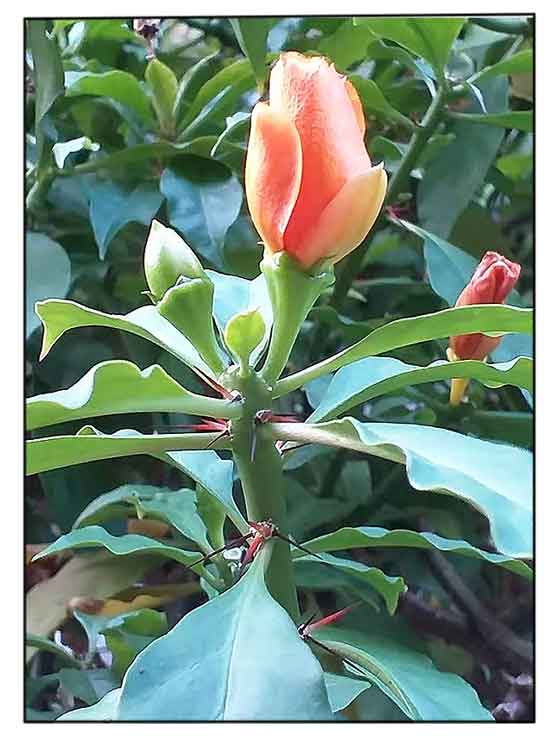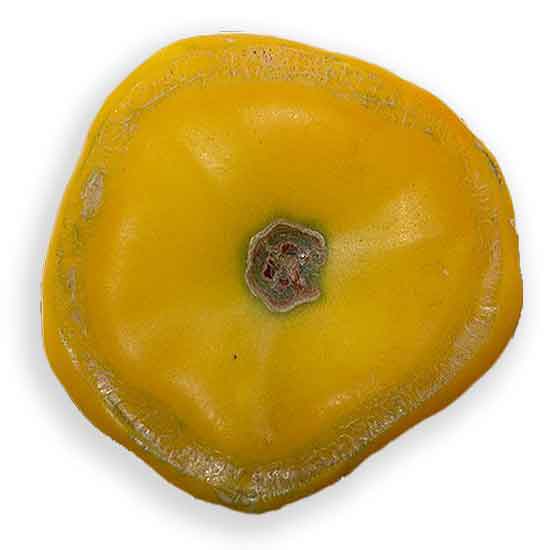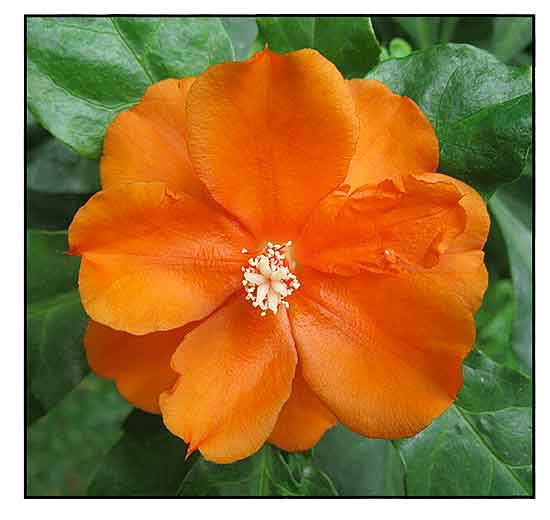 Gen info Gen info
- Cactacea consists of 100 genera and about 2000 species.
-
Leuenbergeria bleo, formerly Pereskia bleo, is a leafy cactus, native to the shady, moist forests of Central America.
-
Species was first described as Cactus bleo by Karl Sigismund Kunth in 1828.
-
The genus unlike other types of cacti in having substantial leaves and thin stems.
Botany
• Leuenbergeria bleo is a shrub or small tree, growing a height of 2 to 8 meters with trunks up to 15 centimeters in diameter. Branches are smooth, olive-green to brownish gray. Leaves are arranged alternately on the branches, distinctly stalked with petioles up to 3 centimeters long. Leaf blade is 6 to 20 centimeters long and 2 to 7 centimeters wide, elliptic to oblong or lanceolate in shape. Leaf blades are five- nerved with four to six, often fork-shaped, side lobes. Thorns are either parallel in bundles or spread widely out. Long thorns on the branches are up to five to ten millimeters long. Along the main shoots there are up to 40 spines per areole, each 2 centimeters long. Flowers are arranged in terminal lateral inflorescences. Flowers are bare, bright red, scarlet, salmon pink or orange-red-pink, 4 to 6 centimeters in diameter. Fruits are conical, truncated in the apex, ripening yellow; edible but sour tasting, containing lenticular seeds with a relatively large surface area of 39.61 mm². Seeds are 7.81 mm long and 6.45 mm wide. (3)
 • A perennial shrub up to 4 m tall. Foliage: Unlike other members of the cactus family (Family Cactaceae) which lack leaves or have tiny leaves which quickly fall off, this species has large leaves which remain on the plant. Green leaves are elliptic with wavy leaf margin. Leaf surface appears wrinkled with leaf blade bulging between veins. Stems: The woody stems are heavily armed with dense clusters of black, needle-like spines. Flowers: Orange-red, rose-like flowers are composed of about 10 obovate to oval petals. Bisexual flowers have a compact column of white stamens and styles in the center. Fruits: Yellow, funnel-shaped fruits are fleshy with several black, disc-shaped seeds. (4) • A perennial shrub up to 4 m tall. Foliage: Unlike other members of the cactus family (Family Cactaceae) which lack leaves or have tiny leaves which quickly fall off, this species has large leaves which remain on the plant. Green leaves are elliptic with wavy leaf margin. Leaf surface appears wrinkled with leaf blade bulging between veins. Stems: The woody stems are heavily armed with dense clusters of black, needle-like spines. Flowers: Orange-red, rose-like flowers are composed of about 10 obovate to oval petals. Bisexual flowers have a compact column of white stamens and styles in the center. Fruits: Yellow, funnel-shaped fruits are fleshy with several black, disc-shaped seeds. (4)
Distribution
- Introduced.
- Cultivated, not naturalized. (2)
-
Native to Colombia, Panama. (1)
 Constituents Constituents
- Phytoconstituents from leaves include alkaloids (3,4-dimethoxy-ß-phenethylamine, 3-methoxytyramine, tyramine), fatty acids (methyl palmitate, methyl linoleate, methyl α-linoleate), flavonoid (vitexin), phytosterol glyycoside (ß-sitosterol glucoside), lactone (dihydroactinidiolide), phenolic compounds (2,4-ditert-butylphenol, α-tocopherol, catechin, epicatechin, quercetin, myricetin), sterols (campesterol, stigmasterol, ß-sitosterol), terpenoids (ß-carotene, phytol); from fruits, carotenoids (lutein and zeaxanthine). (4)
- Study for mineral contents of leaves
of P. bleo yielded percentage weight (% w/w): carbon 50.6, oxygen 35.4, magnesium 0.4, phosphorus 0.4, sulfur 1.5, chlorine 1.2, potassium 10.2, calcium 0.3; aluminum, silicon, and iron were not detected. (4)
- Crude extract of leaves yielded terpenoids, sterols, alkaloids, fatty acids, phenolic compounds, along with γ-sitosterol, ß-tocopherol, and γ-tocopherol. (see study below) (5)
- Study of leaf extracts yielded high amounts of bioactive compounds including total phenolic compounds (109.43 mg GAE/g), epicatechin (575 mg/100g), quercetin (110.94 mg/100g), catechin (
918 mg/100g), and myricetin (9.49 mg/100g); and α-tocopherol, ß-carotene, and lycopene (69, 51.97 mg/100g, and 92.46 µg/g respectively). (see study below) (6)
Properties
- Studies have suggested antioxidant, anticancer, antiproliferative, antibacterial, anti-candida properties.
Parts used
Leaves, flowers, fruits.
Uses
 Edibility Edibility
- Fruits are edible.
- Used as dietary vegetable.
- In Malaysia and China, eaten raw as vegetable or drunk as brewed concoction of dried leaves.
Folkloric
- No reported folkloric medicinal usage in the Philippines.
-
In Malaysia, used to treat rheumatism ulcers. Users report use of leaves, tips and flowers was alone effective against cancer, hypertension, boils, and diabetes; also used as health supplement. Gel from the fruit reported to relieve itches and skin swellings.
(9)
- Decoction of leaves used as warm bath to relieve muscle aches. Poultice of leaves applied to boils.
- Leaves have been
used for treatment of
cancer, hemorrhoids, hypertension, diabetes, stomach pains, ulcers, asthma, rheumatism. Decoction of leaves and/or fruit used for detoxification and prevention of cancer. Indigenous Columbians used P. bleo to neutralize snake bites, relax spastic muscles, and alleviate muscle aches. In Central America, Kuna Indians used crushed leaves to clarify drinking water. (4)
Others
- Barrier hedge.
- Insect repellent.
Studies
• Antiproliferative: Studies have reported effects of different P. bleo extracts on various cancer cell lines in vitro. A crude methanol extract and ethyl acetate fraction showed significant cytotoxic effects against human nasopharyngeal epidermoid carcinoma cell line (KB). The EA fractions showed more activity than the ME against human colon carcinoma (HCT116) and hormone dependent breast carcinoma cell lines (MCF7). (4)
• Cytotoxicity against Cancer Cell Lines / Leaves: Study evaluated crude solvent extracts of Pereskia bleo leaves for cytotoxic effect on cancer cell lines. The ethyl acetate extract exhibited potent cytotoxic effect against HeLa and MDA-MB-231 cancer cells with IC50s of 17.51 and 31.80 µg/mL respectively. (see constituents above) (5)
• Antioxidant / Leaves: Study evaluated the antioxidant properties of various extracts of Pereskia bleo leaves using DPPH, FRAP, and ß-Carotene-Linoleic acid methods. The ethyl acetate extract showed significantly (p<0.05) higher antioxidant activity than hexane, methanol, and ethanol extracts. (see constituents above) (6)
• Antioxidant / Antibacterial / Leaves: Study evaluated different solvent extracts of leaves for total phenolic content (TPC), antioxidant, and antibacterial activities against four bacteria i.e., Streptococcus pyogenes, Staphylococcus aureus, Escherichia coli and Pseudomonas aeruginosa. Methanolic and chloroform extracts exhibited strong activities against test bacteria. The methanolic extract also exhibited higher TOC and higher antioxidant activity with IC50 of 33.83 µg/mL and higher ability to scavenge free radicals. Results suggest potential as natural source for antibacterial and antioxidant agents. (7)
• Anti-Candida Cysteine-Rich Peptide: Study reports on the identification of 15 novel CRPs (cysteine-rich peptides), bleogens pB1-15. NMR analysis confirmed bleogen pB1 has cystine-knot disulfide connectivity and in silico modeling revealed a cation-polar-cation motif, a signature heparin-binding motif confirmed by heparin affinity chromatography. Cell-based assays showed bleogen pB1 is non-toxic to mammalian cells but functions as an anti-Candida peptide. (8)
• Antibacterial: Study evaluated hexane, dichloromethane, ethyl acetate, and methanol extracts of Pereskia bleo (PB) for antibacterial, antioxidant, and anticancer properties using disc diffusion method DPPH assay, and MTT cytotoxicity tests, respectively. Hexane and methanol extracts showed high and moderate antibacterial activity against P. aeruginosa and S. cholerasuis, respectively. Ethyl acetate extract showed narrow spectrum of activity ( ≈ 35% of streptomycin activity). DCM extract showed highest antibacterial activity on MRSA. Hexane extract showed most effective DPPH free radical scavenging (37.55%). None of the extracts showed significant cytotoxicity towards MCF-7, HT-29, and CEM-SS cell lines after 72 h incubation time. (10)
Availability
- Wild-crafted.
- Cultivated.
- Plants in the cybermarket. |

![]()




 • A perennial shrub up to 4 m tall. Foliage: Unlike other members of the cactus family (Family Cactaceae) which lack leaves or have tiny leaves which quickly fall off, this species has large leaves which remain on the plant. Green leaves are elliptic with wavy leaf margin. Leaf surface appears wrinkled with leaf blade bulging between veins. Stems: The woody stems are heavily armed with dense clusters of black, needle-like spines. Flowers: Orange-red, rose-like flowers are composed of about 10 obovate to oval petals. Bisexual flowers have a compact column of white stamens and styles in the center. Fruits: Yellow, funnel-shaped fruits are fleshy with several black, disc-shaped seeds. (
• A perennial shrub up to 4 m tall. Foliage: Unlike other members of the cactus family (Family Cactaceae) which lack leaves or have tiny leaves which quickly fall off, this species has large leaves which remain on the plant. Green leaves are elliptic with wavy leaf margin. Leaf surface appears wrinkled with leaf blade bulging between veins. Stems: The woody stems are heavily armed with dense clusters of black, needle-like spines. Flowers: Orange-red, rose-like flowers are composed of about 10 obovate to oval petals. Bisexual flowers have a compact column of white stamens and styles in the center. Fruits: Yellow, funnel-shaped fruits are fleshy with several black, disc-shaped seeds. (

